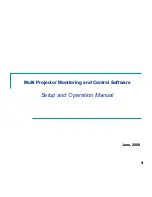
Configuring Slots and Ports on a Switch
ExtremeWare XOS 11.1 Concepts Guide
88
You can control the field examined by the switch for address-based load sharing when the load-sharing
group is created by using the following command:
enable sharing {<master_port>} grouping <port_list> {algorithm address-based [L2 |
L3]}
or
by using the following command after the load-sharing group has been created:
configure sharing {<master_port>} algorithm address-based [L2 | L3]
If the packet is not IP, the switch applies the Layer 2 algorithm, which is the default setting.
Load-Sharing Algorithms on the BlackDiamond 10K Switch
You can configure one of two load-sharing, or link aggregation, algorithms on the BlackDiamond 10K
switch, as follows:
●
Port-based—Uses the ingress port to determine which physical port in the load-sharing group is
used to forward traffic out of the switch.
●
Address-based—Uses addressing information to determine which physical port in the load-sharing
group to use to forward traffic out of the switch. Addressing information is based on the packet
protocol, as follows:
■
IP packets—Uses the source and destination MAC and IP addresses and the TCP port number.
■
All other packets—Uses the source and destination MAC address.
If you do not explicitly select an algorithm, the port-based scheme is used. However, the address-based
algorithm has a more even distribution and is the recommended choice.
Address-based load sharing.
When you configure address-based load sharing, the switch examines a
specific place in the packet to determine which egress port to use for forwarding traffic:
●
For Layer 2 load sharing, the switch uses the MAC source address and destination address.
●
For Layer 3 load sharing, the switch uses the IP source address and destination address.
●
For Layer 4 load sharing, the switch using the TCP source and destination port number.
You can control the field examined by the switch for address-based load sharing by using the following
command:
configure sharing address-based [L2 | L2_L3 | L2_L3_L4 | L2_L3_CHK_SUM |
L2_L3_L4_CHK_SUM]
where CHK SUM indicates that the switch should examine the IP check sum. Examining the IP check
sum in addition to the other parameters produces a random traffic pattern on the egress of the load-
sharing links because the IP check sum includes the packet length, which is likely to change from
packet to packet.
This feature is available for the address-based load-sharing algorithm only. The selected address-based
algorithm is applied to the entire switch, to all the load-sharing groups configured as address-based.
Layer 2 is the default setting.
The master port of the load-sharing group can be the monitor port for port-mirroring.
Summary of Contents for ExtremeWare XOS 11.1
Page 16: ...Contents ExtremeWare XOS 11 1 Concepts Guide 16...
Page 20: ...Preface ExtremeWare XOS 11 1 Concepts Guide 20...
Page 21: ...1 Using ExtremeWare XOS...
Page 22: ......
Page 78: ...Managing the ExtremeWare XOS Software ExtremeWare XOS 11 1 Concepts Guide 78...
Page 168: ...Virtual LANs ExtremeWare XOS 11 1 Concepts Guide 168...
Page 200: ...Policies and ACLs ExtremeWare XOS 11 1 Concepts Guide 200...
Page 252: ...Security ExtremeWare XOS 11 1 Concepts Guide 252...
Page 265: ...2 Using Switching and Routing Protocols...
Page 266: ......
Page 294: ...Ethernet Automatic Protection Switching ExtremeWare XOS 11 1 Concepts Guide 294...
Page 354: ...Extreme Standby Router Protocol ExtremeWare XOS 11 1 Concepts Guide 354...
Page 416: ...IP Multicast Routing ExtremeWare XOS 11 1 Concepts Guide 416...
Page 417: ...3 Appendixes...
Page 418: ......
Page 432: ...Software Upgrade and Boot Options ExtremeWare XOS 11 1 Concepts Guide 432...
















































